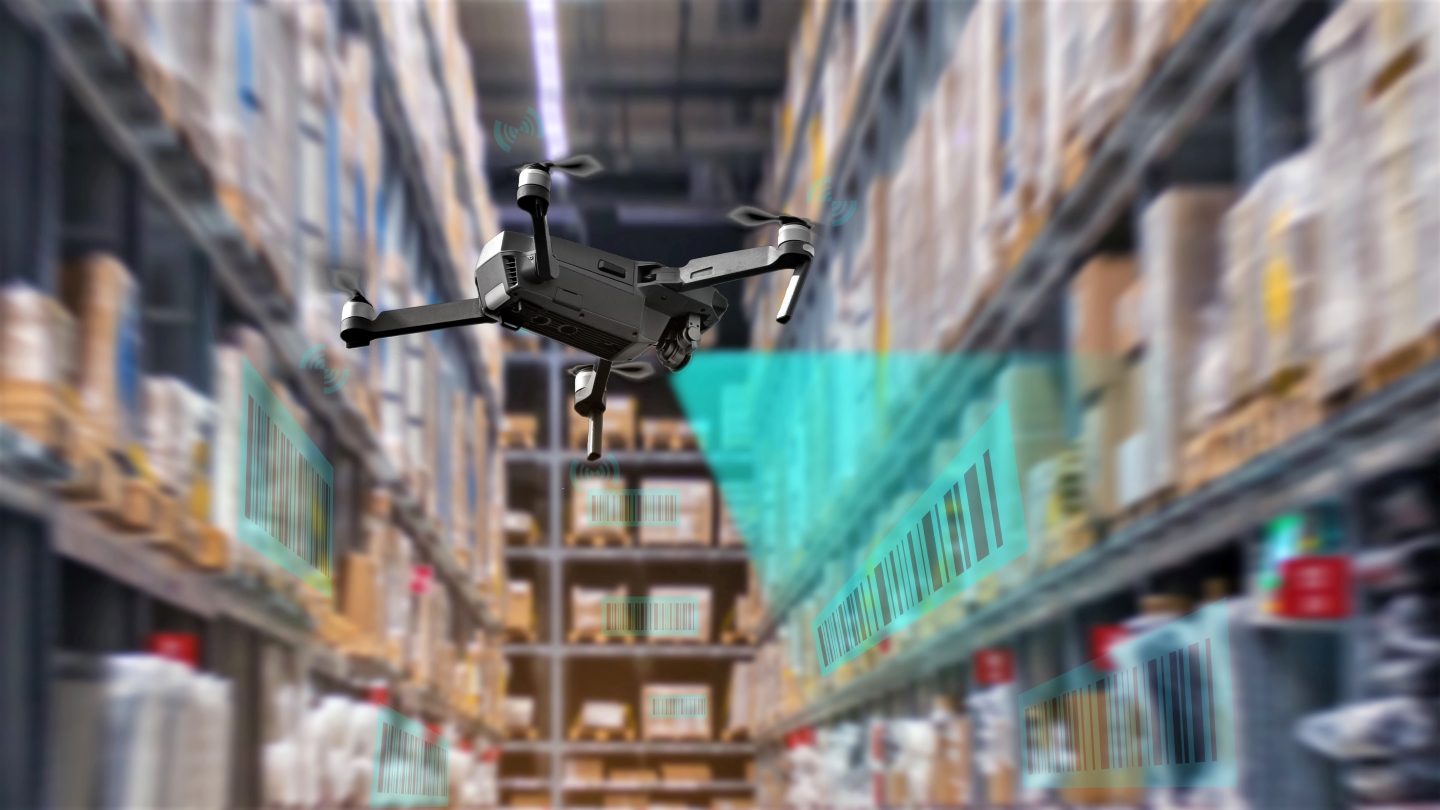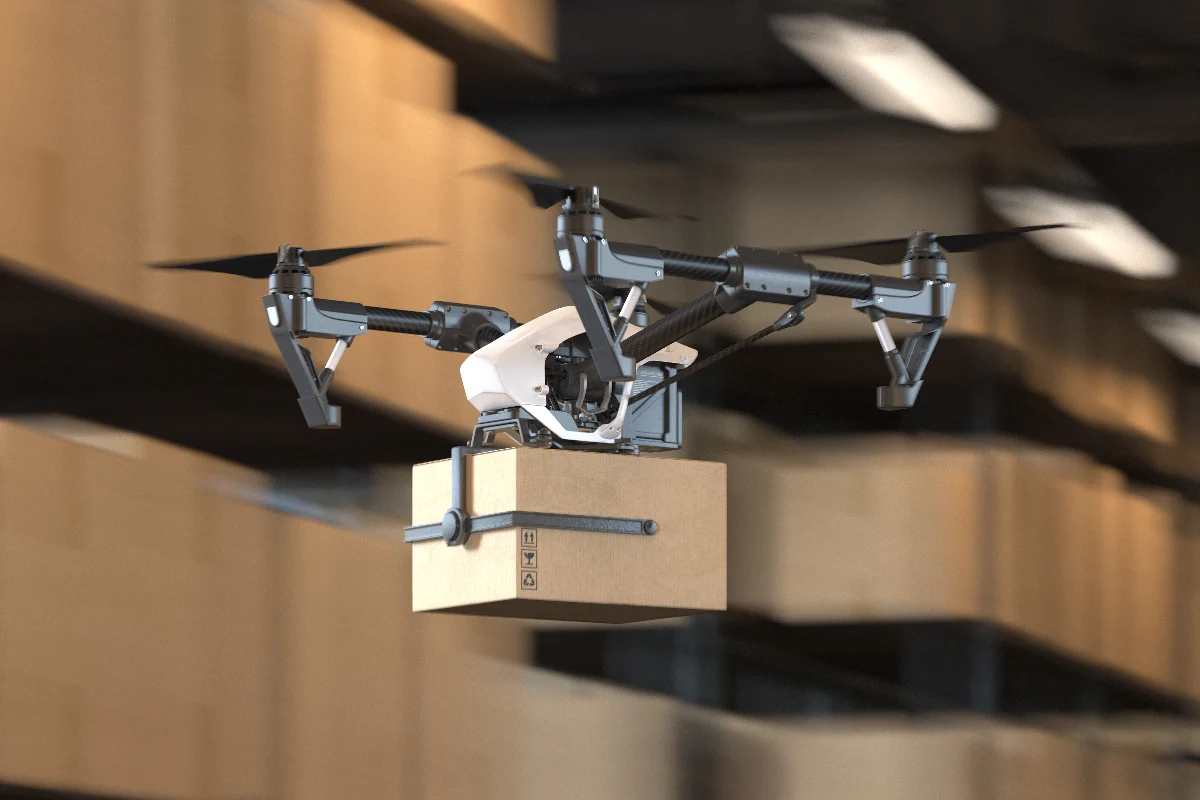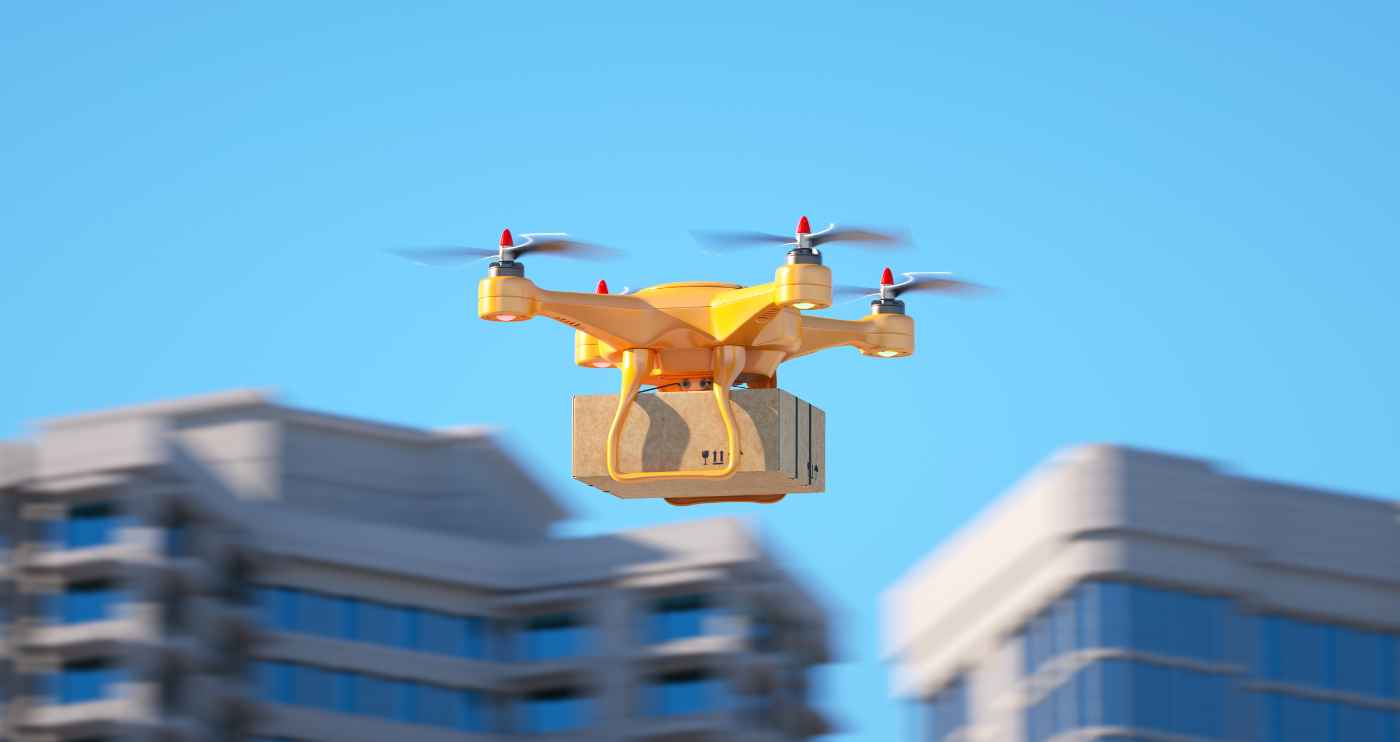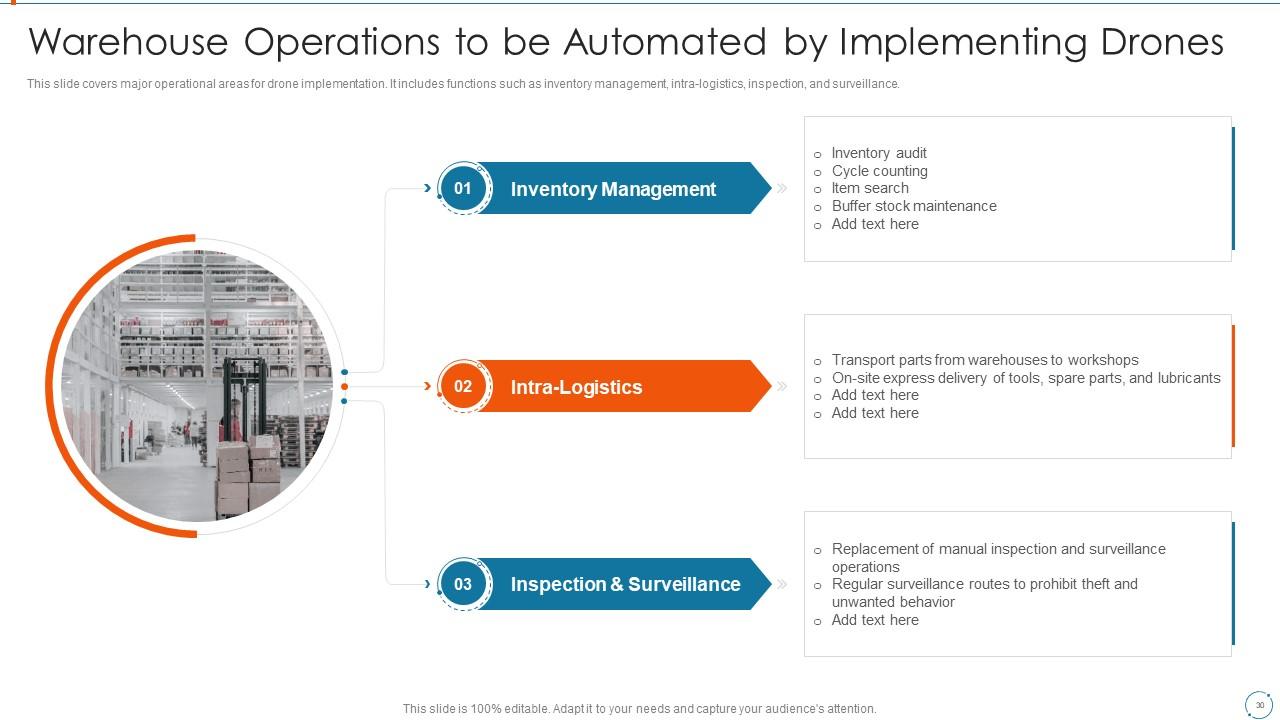
In an era where speed and precision are paramount,How Drones Can Improve Supply Chain Management, drones are revolutionizing the world of supply chain management. These high-flying marvels offer a game-changing solution for businesses seeking to enhance their logistics operations. Imagine a future where drones can swiftly and autonomously transport critical goods, conduct rapid inventory checks, and monitor remote warehouses, all while reducing costs and human error.
But it doesn't stop there. Drones also provide real-time data, giving businesses an unparalleled level of visibility into their supply chain. With advanced sensors and cameras, they can monitor temperature-sensitive products, ensure compliance with regulatory standards, and even address unexpected disruptions promptly. By leveraging this technology, companies can not only meet the demands of a fast-paced market but also stay ahead of the competition. Drones are not just the future of supply chain management.
How Drones Can Improve Supply Chain Management
Drones can performsupply chain management in a variety of ways, including:
- Inventory management -Drones can be used to automate inventory management tasks, such as counting inventory levels, tracking the movement of goods, and identifying potential stockouts. This can help businesses to improve inventory accuracy, reduce costs, and improve customer satisfaction.
- Warehousing and picking - Drones can be used to automate warehousing and picking tasks, such as transporting goods, picking items for orders, and packing orders for delivery. This can help businesses to improve the efficiency of their warehousing and picking operations, reduce costs, and improve delivery times.
- Delivery -Drones can be used to deliver goods to customers, especially in remote or hard-to-reach areas. This can help businesses to expand their reach, reduce delivery costs, and improve customer satisfaction.
- Inspection and maintenance -Drones can be used to inspect warehouses, factories, and other facilities for damage or safety hazards. Drones can also be used to inspect and maintain infrastructure, such as pipelines and power lines. This can help businesses to identify and resolve potential problems quickly and efficiently, reduce costs, and improve safety.
- Data collection and analysis -Drones can be equipped with sensors to collect data on inventory levels, product quality, and other factors. This data can be analyzed to identify trends and patterns, which can help businesses to make better decisions about their supply chains.
Here are some specific examples of how drones are being used to perform supply chain management today:
- Walmart is using drones to inspect its warehouses for damage -This helps Walmart to identify and resolve potential problems before they cause delays or disruptions.
- Amazon is using drones to deliver packages to customers in rural areas -This helps Amazon to reduce transportation costs and reach customers who would otherwise be underserved.
- UPS is using drones to deliver packages to customers in urban areas -This helps UPS to reduce traffic congestion and improve delivery times.
- DHL is using drones to deliver medical supplies to remote villages in Africa - This helps DHL to provide life-saving supplies to people who would otherwise not have access to them.
- The US military is using drones to deliver food and ammunition to troops in combat zones -This helps the military to provide its troops with the supplies they need to stay safe and effective.
Efficient And Cost-Effective
Efficient and cost-effective supply chain management is the ability to deliver the right products to the right customers at the right time at the lowest possible cost. This requires a holistic approach that considers all aspects of the supply chain, from procurement to production to transportation to delivery.
There are a number of ways to achieve efficient and cost-effective supply chain management. Some key strategies include:
- Proactive planning and forecasting -By carefully planning and forecasting demand, businesses can avoid overstocking and understocking, which can lead to waste and unnecessary costs.
- Consolidation and rationalization of suppliers -By working with fewer, more reliable suppliers, businesses can negotiate better deals and reduce complexity in the supply chain.
- Investment in technology - Technology can help businesses to automate tasks, improve visibility into the supply chain, and make better decisions.
- Collaboration with partners -By collaborating with suppliers, transportation providers, and other partners, businesses can create a more efficient and cost-effective supply chain.
Here are some specific examples of how drones are being used to improve supply chain management in a cost-effective way today:
- Walmart is using drones to deliver groceries to customers in rural areas -This helps Walmart to reduce the cost of transportation and reach customers who would otherwise be underserved.
- Amazon is using drones to deliver packages to customers in a matter of minutes - This helps Amazon to reduce delivery times and improve customer satisfaction.
- UPS is using drones to inspect its warehouses and delivery vehicles for damage -This helps UPS to identify and resolve potential problems before they cause delays or disruptions.
Improved Customer Service And Satisfaction
Drones can improve customer service and satisfaction in a number of ways, including:
- Faster delivery times - Drones can deliver goods to customers much faster than traditional delivery methods, such as trucks and cars. This can be especially beneficial for customers who need their goods quickly, such as businesses or customers in rural areas.
- More convenient delivery options -Drones can deliver goods to customers in remote or hard-to-reach areas, such as rooftops or gated communities. This can give customers more convenient delivery options and make it easier for them to receive their goods.
- More personalized delivery experiences - Drones can be used to deliver goods to customers in a more personalized way. For example, drones can be used to deliver gifts directly to customers' doorsteps, or to deliver food to customers at their desired location.
- Enhanced customer engagement -Drones can be used to engage customers in new and innovative ways. For example, drones can be used to provide customers with real-time updates on their delivery status, or to offer customers the ability to interact with their deliveries remotely.
Here are some specific examples of how drones are being used to improve customer service and satisfaction today:
- Restaurants are using drones to deliver food to customers' homes -This can be especially convenient for customers who are ordering food late at night or who are in a hurry.
- E-commerce retailers are using drones to deliver packages to customers' doorsteps - This can help retailers to reduce delivery times and improve customer satisfaction.
- Retailers are using drones to provide customers with real-time updates on their inventory levels and to offer customers the ability to purchase items directly from the drone - This can help retailers to improve the customer experience and increase sales.
Drones have the potential to revolutionize customer service and satisfaction by making deliveries faster, more convenient, more personalized, and more engaging. As drone technology continues to develop, we can expect to see even more innovative and customer-centric applications in the future.
Reduced Costs And Increased Efficiency
Drones can help businesses to reduce costs and increase efficiency in a number of ways, including:
- Reduced labor costs - Drones can automate many tasks that are currently performed manually, such as inventory picking and packing, delivery, and inspections. This can help businesses to reduce labor costs and free up human resources for other tasks.
- Reduced transportation costs -Drones can be used to deliver goods directly to customers, eliminating the need for traditional modes of transportation, such as trucks and ships. This can help businesses to reduce transportation costs, especially for last-mile deliveries.
- Reduced fuel costs -Drones are more fuel-efficient than traditional modes of transportation, such as trucks and cars. This can help businesses to reduce their fuel costs and environmental impact.
- Increased productivity -Drones can help businesses to increase productivity by automating tasks and improving visibility into the supply chain. This can help businesses to produce more goods and services in less time.
- Reduced waste - Drones can help businesses to reduce waste by tracking inventory levels more accurately and identifying potential stockouts more quickly. This can help businesses to avoid overstocking and understocking, which can lead to waste.
Here are some specific examples of how drones are being used to reduce costs and increase efficiency today:
- Walmart is using drones to inspect its warehouses for damage - This helps Walmart to identify and resolve potential problems before they cause delays or disruptions, which can save the company money.
- Amazon is using drones to deliver packages to customers in rural areas -This helps Amazon to reduce transportation costs and reach customers who would otherwise be underserved, which can help Amazon to increase sales and profits.
- UPS is using drones to deliver packages to customers in urban areas -This helps UPS to reduce traffic congestion and improve delivery times, which can save the company money and improve customer satisfaction.
Improved Delivery Times
Drones can help to improve delivery times in a number of ways, including:
- Flying directly to the destination -Drones can fly directly to the destination of a delivery, avoiding traffic congestion and other delays. This can significantly reduce delivery times, especially for last-mile deliveries.
- Operating in all weather conditions -Drones can operate in all weather conditions, including rain, snow, and wind. This means that drones can be used to deliver goods even when traditional modes of transportation are delayed or canceled.
- Reaching remote or hard-to-reach areas -Drones can be used to deliver goods to remote or hard-to-reach areas, such as islands, mountain communities, and disaster zones. This can help to improve delivery times in areas that are not well-served by traditional modes of transportation.
Here are some specific examples of how drones are being used to improve delivery times today:
- Walmart is using drones to deliver groceries to customers in rural areas -This helps Walmart to reduce delivery times and reach customers who would otherwise be underserved.
- Amazon is using drones to deliver packages to customers in a matter of minutes -This helps Amazon to reduce delivery times and improve customer satisfaction.
- UPS is using drones to deliver packages to customers in urban areas - This helps UPS to reduce traffic congestion and improve delivery times.
In addition to the benefits listed above, drones can also help to improve delivery times by:
- Reducing the number of handoffs -Drones can deliver goods directly to customers' doorsteps, eliminating the need for multiple handoffs between different transportation providers. This can help to reduce delivery times and improve the efficiency of the delivery process.
- Improving visibility into the delivery process - Drones can be equipped with GPS tracking and other sensors that can provide real-time updates on the location and status of a delivery. This information can be used to improve visibility into the delivery process and identify potential delays more quickly.
- Automating tasks -Drones can automate tasks such as inventory picking and packing, delivery, and inspections. This can help to reduce delivery times and free up human resources for other tasks.
Greater Flexibility And Adaptability
Drones can provide greater flexibility and adaptability in supply chain management in a number of ways, including:
- On-demand delivery -Drones can be used to deliver goods on-demand, which can help businesses to meet the needs of their customers more quickly and efficiently.
- Dynamic routing - Drones can be programmed to fly dynamic routes, which can help businesses to adapt to changing conditions and deliver goods more efficiently.
- Multi-modal transportation -Drones can be used in conjunction with other modes of transportation, such as trucks and ships, to create more flexible and adaptable supply chains.
- Real-time visibility -Drones can be equipped with sensors that can provide real-time visibility into the status of shipments and inventory levels. This information can be used to make better decisions about the allocation of resources and to improve the overall efficiency of the supply chain.
- Disaster response -Drones can be used to deliver emergency supplies to disaster zones quickly and efficiently.
Here are some specific examples of how drones are being used to provide greater flexibility and adaptability in supply chain management today:
- Amazon is using drones to deliver packages to customers on-demand -This helps Amazon to meet the needs of its customers more quickly and efficiently.
- UPS is using drones to deliver packages to remote or hard-to-reach areas -This helps UPS to provide more flexible and adaptable delivery solutions to its customers.
- Walmart is using drones to inspect its warehouses for damage -This helps Walmart to identify and resolve potential problems quickly and efficiently.
- The US military is using drones to deliver medical supplies to troops in combat zones - This helps the military to provide more timely and effective medical care to its troops.
FAQ's About How Drones Can Improve Supply Chain Management
What Is The Future Of Drone Supply Chain?
The rise of drone delivery is reshaping the logistics industry in profound ways. This advancement holds the promise of substantially enhancing supply chain efficiency. Drones can quickly transport goods between warehouses and distribution centers, reducing transit times and optimizing inventory management.
How Can We Improve Supply Chain Management?
Improving Supply Chain Efficiency with Best Practices
- Adopt automation to data in real-time.
- Increase end-to-end visibility.
- Enhance forecasting accuracy.
- Measure and optimize inventory levels.
- Ensure route optimization.
- Increase collaboration with all stakeholders.
What Are The Advantages Of Drones In Logistics?
Faster and cheaper delivery, One of the main benefits of using drones for last-mile delivery is that they can reduce the time and cost of delivering goods to customers. Drones can fly over obstacles, avoid congestion, and take shorter routes than conventional vehicles.
Conclusion
In conclusion, drones are poised to be the linchpin of supply chain management's transformation in the coming years. With their ability to streamline operations, reduce costs, and enhance efficiency, businesses that embrace drone technology are well-positioned to gain a significant competitive advantage. Drones not only accelerate the delivery process but also provide an unprecedented level of real-time visibility and data-driven insights that allow companies to adapt and respond to changing market dynamics.
As we move forward into this era of innovation, it's clear that the adoption of drones in supply chain management is no longer a matter of if, but when. Those who recognize the immense potential of these aerial devices will be better equipped to meet the demands of an ever-evolving marketplace and deliver superior customer experiences. The future of supply chain management is taking flight, and drones are the vanguard of this exciting revolution.


